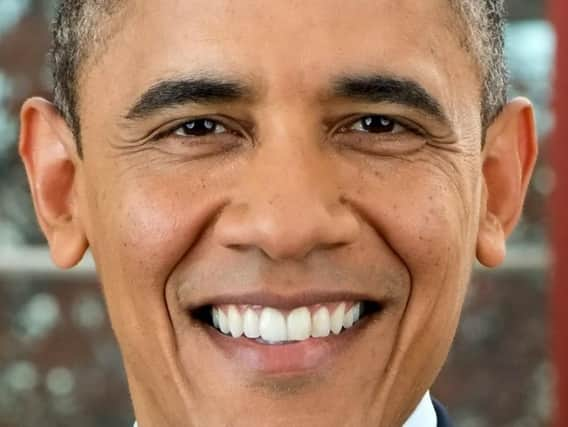People are able to recognise up to a staggering 10,000 faces, say Yorkshire scientists


READ: ‘How Macmillan helped our family after our daughter was diagnosed with Leukaemia...’But the number varies widely between 1,000 and 10,000, with the average person remembering 5,000, according to new research.
For the first time psychologists at the University of York have been able to put a figure on the individuals we know personally and from the media - including the rich and famous
Advertisement
Hide AdAdvertisement
Hide AdThey did this through a method called 'recognition and recall' - realising a person is familiar and retrieving their related details from memory, respectively.
It sheds light on the old line commonly heard at a meeting or party: "I'm good at remembering faces, but terrible at remembering names."
Lead author Dr Rob Jenkins said no one knows why some are better than others at identifying faces.
He said knowing more people may boost this ability - like vocabulary size affects language skills.
Advertisement
Hide AdAdvertisement
Hide AdDr Jenkins said: "Our study focused on the number of faces people actually know – we haven't yet found a limit on how many faces the brain can handle."
He said until now, there has been no way of estimating the number of faces people know.
So his team developed a laboratory technique based on recognition and recall that showed everyone fell within the 1,000 to 10,000 range - with the average about 5,000.
Dr Jenkins said it opens the door to tracking face knowledge across the lifespan and to improvements in combating terrorism and other criminal activities through super recognisers able to pick out suspects in a crowd.
Advertisement
Hide AdAdvertisement
Hide AdHumans have typically lived in small groups of around just 100 individuals.
But we are equipped to deal with the thousands of faces we encounter in the modern world, on our screens as well as in social interactions.
The results provide a baseline with which to compare the size of our "facial vocabulary" with software that is increasingly used to people at airports and in police investigations.
Dr Jenkins said: "The ability to distinguish different individuals is clearly important - it allows you to keep track of people's behaviour over time, and to modify your own behaviour accordingly."
Advertisement
Hide AdAdvertisement
Hide AdREAD: World Mental Health Day is shining a light on the wellbeing of young peopleFor the study, participants spent an hour writing down as many faces from their personal lives as possible, including those they went to school with, colleagues and family.
They then did the same for famous faces, such as actors, politicians, and other public figures.
The participants found it easy to come up with lots of faces at first, but harder to think of new ones by the end of the hour.
That change of pace allowed the researchers to estimate when they would
run out of faces completely.
Advertisement
Hide AdAdvertisement
Hide AdThe participants were also shown thousands of photographs of famous people, such as Barack Obama, and asked which ones they recognised.
The researchers required participants to recognise two different photos of each
person to ensure consistency.
The results published in Proceedings of the Royal Society B: Biological Sciences showed they knew between 1,000 and 10,000 faces.
Dr Jenkins said: "The range could be explained by some people having a natural aptitude for remembering faces.
Advertisement
Hide AdAdvertisement
Hide Ad"There are differences in how much attention people pay to faces, and how efficiently they process the information.
"Alternatively, it could reflect different social environments – some participants may have grown up in more densely populated places with more social input.”
The 25 volunteers were undergraduate or postgraduate male and female students at the universities of Glasgow and Aberdeen between 18 and 61 years old.
The average age was 24 and, according to the researchers, this provides an intriguing avenue for further research.
Advertisement
Hide AdAdvertisement
Hide AdAdded Dr Jenkins: "It would be interesting to see whether there is a peak age for the number of faces we know.
"Perhaps we accumulate faces throughout our lifetimes, or perhaps we start to forget
some after we reach a certain age."
Previous research has found there are three parts of the brain that light up in face recognition - one for the physical aspects, another for identifying it as being familiar or unknown and the third for retrieving the name or other facts linked to it.
These are the right fusiform gyrus, the inferior occipital gyri and the anterior temporal cortex, respectively.
Advertisement
Hide AdAdvertisement
Hide AdRecognising people is an essential skill we often take for granted. Most of us are able to recognise someone even if we haven't bumped into them for 10 years. But the science behind it is only just beginning to be unravelled.
In experiments, 35 years after leaving school, people have proved able to identify 90 percent of their classmates.
Dementia patients with damage to the anterior temporal cortex have a problem finding the name to go with the face.
People with epilepsy triggered by the right fusiform gyrus sometimes believe different faces belong to the same person.
Advertisement
Hide AdAdvertisement
Hide AdCompared with a face-blind person, a rare condition known as prosopagnosia, a super-recogniser might have a slightly larger fusiform.
Or they might show more activity in this area when shown pictures of faces.